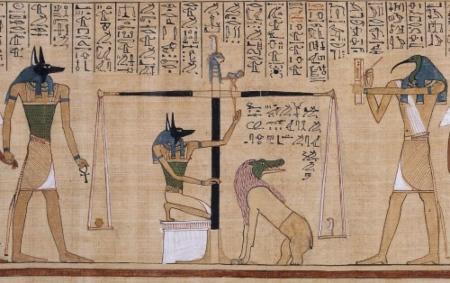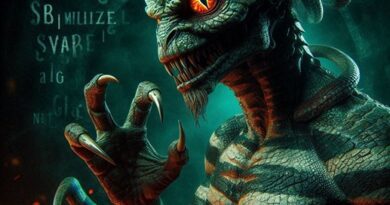The Last Supper: Meet Ammit, Devourer Of The Dead In Eygpt
Almost every culture or religion addresses the question of what happens to our soul after we die, without finding an unequivocal answer. You will likely not want to align with what Egyptian mythology offers on the subject, which looks like it came out of a horror movie. Ammit in Egyptian mythology, known as the “Devourer of the Dead,” is one of the most mysterious and frightening figures in different mythologies.
With a look combining some terrifying animals, a gruesome role in the afterlife, and representations in various texts, Ammit’s place in the world of horror (hopefully not in the afterlife) looks natural.
Who is Ammit, The Devourer Of The Dead In Egypt?
Ammit is an essential figure in Egyptian mythology, representing one of the greatest fears in almost every culture: Death. But this time, the reference is not to causes of death but to what happens to our souls after we die.
According to those who believe that the afterlife is as vital as “life itself” and who took various actions to preserve the immortality of the dead (mainly the mummies), Ammit was an eternal existence beyond the immortality that the Egyptians longed for.
Ammit is part of the Egyptian pantheon of gods and represents negative qualities such as chaos, destruction, and absolute end (unlike most other gods, whose role is to create or protect). As you may have deduced from its name, the belief is that Ammit will reach the souls of the people after death, or more precisely during the heart-weighing ceremony, and do horror.

💀 Killer Deals & Scary Recommendations 💀
🎭 Costumes & Accessories
HalloweenCostumes Fun Costumes Entertainment Earth
🛒 Online Shopping
AliExpress Amazon Walmart Etsy
🧛 Collectibles & Horror Brands
Funko Hot Topic Lego Spirit Halloween
🎢 Attractions & Tours
GetYourGuide Tiqets Viator Klook
📖 Blogs & Horror Sites
Bloody Disgusting iHorror Fangoria
🩸 Disclaimer: Some links are affiliate links. The price stays the same – it just helps keep the site alive 👻
Ammit’s Role in The Weighing Of The Heart Ceremony
According to the Egyptian “Book of the Dead” (texts used in burial rites in ancient Egypt), the heart of every soul that came to the judgment area of the death god Osiris in the Hall of Two Truths was weighed on scales. His heart rested in one hand of the scales, and in the other, the feather of truth, the symbol of Ma’at – the Goddess of justice, law, and truth in Egyptian mythology.
The results of the weighing of the heart ceremony determine what will happen to the deceased. If the weight of the heart was equal to or less than that of the feather, the soul could be satisfied and pass happily to the next world: the meaning is that according to mythology and the results of the test, the soul here is pure from sins.
The problem begins with weighings where the heart is heavier than the feather, which signifies that the person probably sinned more than once in his life. In such cases, the “Swallower of the Dead” would be summoned to devour the heart, and his soul would be condemned to eternal destruction. The meaning is that the deceased could not reach eternal life.
Unlike some legal proceedings today, you can’t appeal on the result of the weighing of the heart ceremony. The reason is that Egyptian belief sees the heart not only as the organ of life but also as the center of the soul and consciousness of the person. If you take the heart out of the picture, the souls simply cannot continue their eternal journey.
If It Looks Like A Crocodile, Lion, And Hippopotamus – It’s Ammit
The depictions of Ammit, the Devourer in Egyptian mythology, present it as a terrifying monster, an appearance consistent with the “job” it got. Ammit is described in most cases as a hybrid creation, combining the features and appearance of the three largest man-eating animals that were known in ancient Egypt:
🐊 A Crocodile’s head – Symbolizing the predatory and cruel nature and the immediate danger that characterizes Ammit. In Egyptian culture, a crocodile is a clear symbol of chaos and the destructive forces of nature. In some descriptions, Ammit’s head appears to have massive jaws and sharp teeth, intensifying fear.
🦁 The body of a Lion – represents the enormous power of Ammit. Ammit’s body is solid and strong, usually in red or dark brown shades. The fact that we are talking about the god-damn king of the jungle here shows that Ammit has a high status in the Egyptian pantheon of monsters
🦛 Hindquarters and a lower body of the Hippopotamus – tend to be thick and robust to enhance the effect. The choice of the hippopotamus is not only because the hippopotamus is a frightening and dangerous animal to man but also to symbolize the apparent connection of the hippopotamus to water and the Nile River. In addition, beyond being a scary place, the Nile is considered the border between the worlds and between life and death.

The Idea: Making Ammit Looks Scary
Likely, the choice of combining several animals in the myth of the Devourer of the Dead in Egypt is anything but accidental. Such a hybrid appearance represents chaos and disorder, which we link to death and the loss of eternity. Of course, it is challenging to find realism in the description of the Egyptian gods. However, in most cases, the representation of a god is by only one animal, or at most a person with the head of an animal, and not a combination of several scary animals.
With or without a connection to these animals, you’ll usually find Ammit appearing in relatively dark colors. The main reason is that these colors are associated with dangers, death, and other harmful aspects. Ammit is usually depicted as a gigantic creature, more extensive than humans, to emphasize its power and the inability of humans to resist it (obviously, the fact that they die during the encounter with Ammit can contribute to this).
In most of the descriptions of the Devourer of the Dead in Egypt, you will also find large, bright eyes with penetrating eyes. Such eyes are connected to the role of a judge, who is supposed to recognize the nature of the souls in front of him. The open mouth, also prominent in many descriptions, expresses the danger and terror associated with this ancient Egyptian Goddess. Generally, we can say that the complex and menacing appearance of Ammit reflects its essential role in Egyptian mythology as the guardian of moral balance and as the one who gives final punishment to sinners.
Here is a video from Jon Solo, who explains on his great channel about many myths and stories from all over the world – including the one of Ammit.
Why Ammit Is Not So Famous In The West?
Egyptian mythology has many gods, with the official numbers talking about 2,000 gods. In such a quantity, it is clear that there are gods who are more famous and others less so.
Although Ammit was a critical and horrific figure, it was not one of the most popular gods in everyday worship. Her appearances were mostly in contexts related to death and the afterlife, which emphasizes its specific role in Egyptian mythology (as crucial as that is). Following that, it’s not at all confident that Ammit is the first name that comes to your mind when you think of ancient Egypt.
Like other mythological figures in ancient Egypt, diverse archeological findings from ancient times show Ammit in several variations:
- The Book of the Dead and Papyrus (ancient sheets of paper from the papyrus plant)
- Other Ceremonial Papyri
- Tomb walls
- Sarcophagi (Egyptian coffins)
- Reliefs or wall paintings in temples, especially those depicting the judgment of the dead
- Burial objects – Archeologists found objects in the shape of Ammit in tombs in Egypt. These items were put there to provide the deceased with protection in the “judgment” process
- Texts from Egyptian mythology from different periods
- Ancient Egyptian calendars
- Different forms of art

Ammit is also present in Western culture, even if not as widespread as other ancient gods (in or outside of Egypt), and certainly not like the mummies, perhaps the immediate connection of horror fans with ancient Egypt.
The character of Ammit, with a comic twist, was a central part of the television series “Moon Knight” from the Marvel Cinematic Universe. The series is about a mercenary with a split personality named Mark Spector (Oscar Isaac), who enters a mystery that combines several evil gods with his multiple identities – including Ammit.
Here are some more mentions of Amot:
- Modern fantasy and mythology books, such as “The Kane Chronicles” series by Rir Riordan – fantasy and adventure books for boys dealing with two brothers who embark on a journey between gods and the many stories of Egyptian mythology. These books are somewhat similar to the “Percy Jackson and the Olympians” series, “by the same writer, referring to stories from Greek mythology.
- The animated series “Mummies Alive” from 1997 is part of the craze for mummy stories in the 90s. In the series, the main villain summons Amot, who makes a mess.
- In video games like “Smite” and “Age of Mythology,” Ammit is probably presented as a monstrous and murderous character.
Unfortunately, we don’t know of any horror films that deal with the character of the Swallower of the Dead, although I think it could be an excellent idea. Take, for example, the 2014 Found Footage film “The Pyramid” with Ashley Hinshaw, perhaps one of the biggest misses of the last decade. While writing this text, I tried to remember whether the movie, which included an encounter of archaeologists with monsters and other creatures inside a pyramid, also included Emot. The answer seems negative from my research, which did not include watching the movie once again (thank god!). Despite this, Ammit appears in some of the wall paintings the researchers see inside the pyramid.
Another aspect of “The Pyramid” regards the appearance of Anubis, one of the villains. Anubis is a god in Egyptian mythology who often combines the body of a man and the head of a jackal, who was also associated with death and was present in the heart-weighing ceremony according to mythology. Anubis includes elements reminiscent of a crocodile in the film, perhaps to associate him with amethysts.
Maybe it really is time for a horror movie where the Death Eater is the main villain. Certainly, the result will not be much worse than the latest adaptation of the film “The Mummy”, with Tom Cruise.




